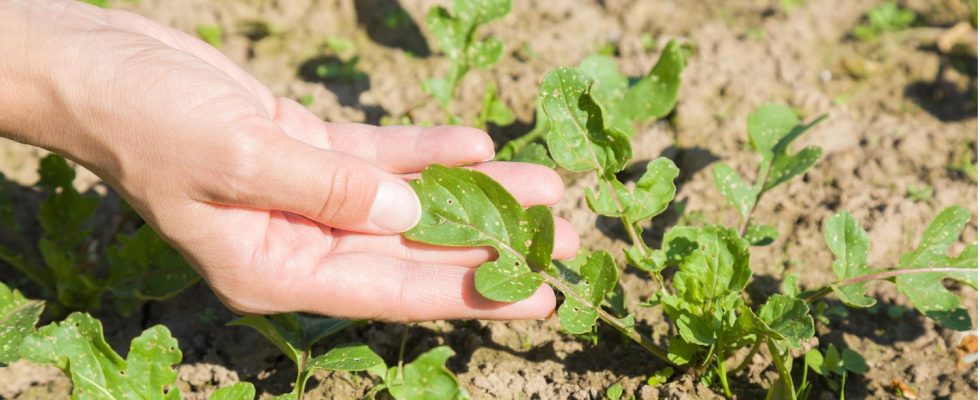pests
Holey leaves in the vegetable patch? This little bug is behind it
Typical signs of flea infestation are perforated leaves
© FotoDuets / Getty Images
Whether rocket or kohlrabi, radishes or broccoli: If the leaves of growing cruciferous plants are heavily perforated, there is a high probability that flea beetles have eaten their fill. You can find out what type of pest it is and what you can do against the infestation as follows.
In fact, these are not real fleas, but rather tiny bugs that are only a few millimeters in size. They owe their name to their powerful hind legs, which they use to jump from leaf to leaf, just like real fleas. Their diet includes not only the young leaves of ground-level vegetables from the cruciferous family, but also nightshades such as tomatoes and potatoes, aubergines and peppers. The bad news is that there are no approved pesticides for home use to control flea beetles. The good news is: With the right measures, you can stop the infestation and prevent damage caused by feeding.
Recognize flea beetles: That speaks for an infestation
The beetles, which are two to four millimeters in size, can differ from one another visually: potato flea beetles have a rather dark brown shell with yellow vertical stripes and prefer nightshade plants. Rape flea beetles, on the other hand, have a blue-black to dark green shimmering shell and prefer to eat the young plants of cruciferous plants such as rocket. The resulting holes on the leaves are small and round, but the edges remain undamaged. This is how the typical window damage occurs – a clear sign that your vegetables have been infested with flea beetles.
Depending on the weather conditions, flea beetles can go through one to two generations per gardening season. In the spring, the females begin laying their eggs in the soil planting vegetable beds. The larvae then feed on the roots for a few weeks without noticeably harming the plants and pupate. The beetles that hatch between June and August, on the other hand, have a big appetite and attack all young plants near the ground. Only in autumn, when it gets colder, do the flea beetles look for winter quarters – usually in the ground or under dead plant compost.
Fight flea beetles: you can do that
As already mentioned, there are currently (still) no commercially available pesticides that are approved for private use. You can still take sensible steps to control flea beetles. These include the following:
- Fleas prefer dry soil. It is all the more important to water the soil around your young plants regularly. In order to keep the moisture in the soil, it makes sense to cover the soil with fresh lawn clippings or a layer bark mulch to cover
- The small beetles prefer a quiet place, so it is uncomfortable for them if the soil is regularly loosened. Work the soil with one as often as possible garden hoein order to repeatedly disturb and thus prevent the pupation of the larvae.
- The weekly pollination of the leaves of young plants with rock flour and algae lime should also help to combat flea beetles. Alternatively, you can also use a plant manure – made of tansy, wormwood or onions and garlic.
- So-called nematodes should also help in a natural way to drive away flea beetles. The threadworms, which are harmless to humans, target the larvae of the beetle. The powder is simply stirred into the irrigation water.
- Since flea beetles jump from leaf to leaf, you can place small sticky traps between the plants. All you need is a solid base, for example a piece of wood, which you can take with you caterpillar glue coat. The bugs then stick to it.
Prevent flea beetles: This is how it works
You can take preventive measures to ensure that the ravenous beetles don’t even start tampering with your vegetables – for example by sowing all sprouts and seedlings early, provided the weather conditions are right. This allows your young plants to outgrow the critical period of a possible infestation more quickly. As a result, it is all the more important to optimally supply your vegetable beds: with nutrients (e.g. fresh compost soil) that stimulate growth. In addition, you can plant your beds in the spring with a fine mesh protect.
To combat flea beetles, you can also encourage their natural predators such as hedgehogs in the garden – with suitable accommodation such as piles of leaves, stacks of dead wood or a special hedgehog house. Alternatively, leaf beetles have their eye on flea beetles: these nocturnal animals prefer to hide under stones or wood during the day, provided there are enough of them in your garden. Or you can take an old one clay pot, fill it with straw and hang it upside down. This allows the leaf beetle to hide in it during the day and hunt the flea beetle at night.
source: “my beautiful garden“
You might also be interested in:
This article contains so-called affiliate links. Further information are available here.


